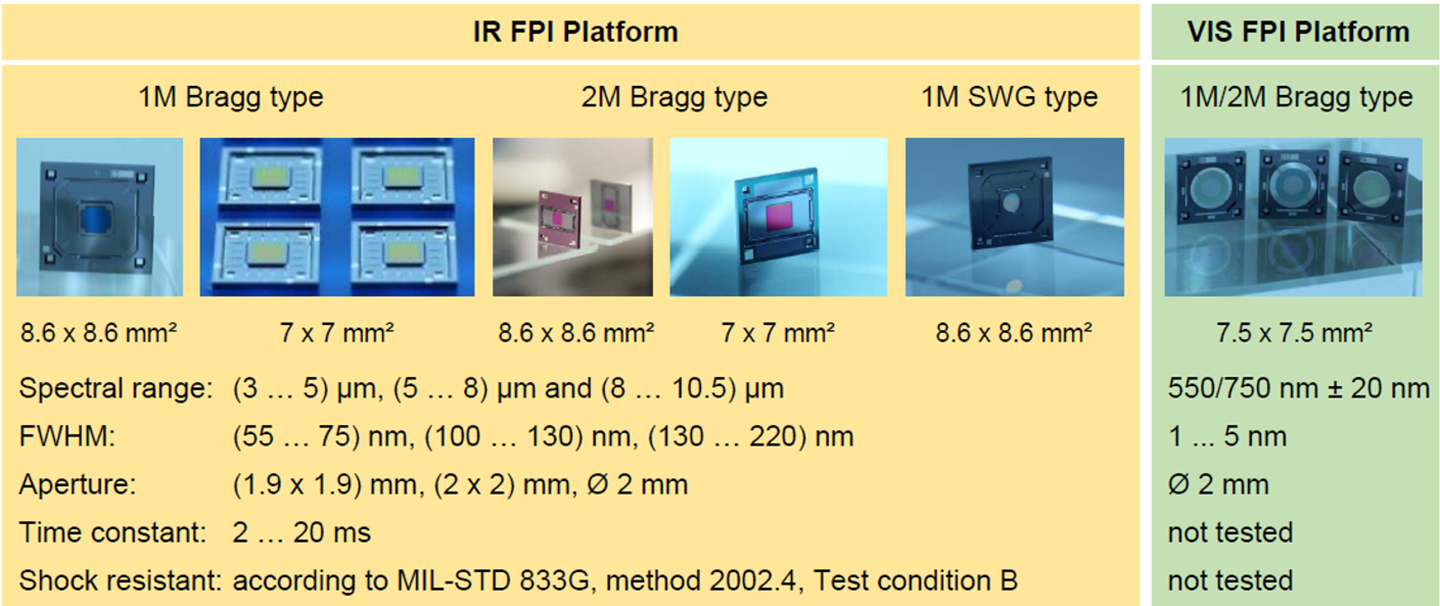Spectral tunable filters

The electrically tunable optical band‐pass filters are miniaturized Fabry‐Pérot interferometers. They consist of an optical resonator, which is built between two highly reflecting mirrors. The resonator transmits light of the resonant wavelengths only and therefore has a very narrow band‐pass characteristic. This is ideally suited for filter applications or the spectral decomposition of light in spectral sensors or spectroscopy. The mirrors are integrated in a supporting MEMS structure with electrostatically movable carriers. The filter chips are fabricated at wafer level from two silicon substrates, which are assembled by silicon fusion bonding. The Fabry‐Pérot interferometers are developed by Fraunhofer ENAS and the Zentrum für Mikrotechnologien of TU Chemnitz together with the German company InfraTec GmbH. InfraTec GmbH integrates the filter chips in very tiny detector modules, which are typically used in industrial and medical gas analyzers, as well as warning and safety systems. Fraunhofer ENAS and the Zentrum für Mikrotechnologien of TU Chemnitz are interested in further enhancements of the tunable filters to address new technologies such as miniaturized spectral imaging sensors and imaging spectroscopy in various applications like handheld analyzers, vehicle sensors, material characterization and agriculture. The filters are applicable for visible light (VIS), short‐wave infrared (SWIR), mid‐wave infrared (MWIR) and long‐wave infrared (LWIR).
Fields of application are in general
- Spectral sensors and spectroscopy (VIS, SWIR, MWIR, LWIR)
- Spectral image sensors and imaging spectroscopy (VIS, SWIR, MWIR, LWIR)
and more specifically
- Warning and safety systems (e.g. for firefighters, miners, police)
- Industrial and medical gas analyzers
- ATR sensors
- Sensor networks
- Handheld devices
- Manned and unmanned vehicles
- Material characterization
- Agriculture
State of the art
The current filter chips for MWIR (3 to 5 μm) and LWIR (5 to 8 μm and 8 to 11 μm) have reached TRL 6 (technology readiness level). Filter chips for the VIS range have reached TRL 4. The filter chips are very robust and are tested according to Mil‐Std 883G, method 2002.4, test condition B, with 1500 g, 0.5 ms pulses.
Benefits in comparison to competitors
- Small size: The size of the latest chips is 5 mm x 5 mm x 0.6 mm (length, width, thickness).
- Large aperture: All tunable filters have an aperture with a diameter of at least 1.9 mm.
- Continuously tunable: The band‐pass filters can be tuned continuously by a single control voltage.
- Very low power consumption: There is no significant current necessary to actuate the filters, only the charging current of the capacitive MEMS actuator.
 Fraunhofer Institute for Electronic Nano Systems
Fraunhofer Institute for Electronic Nano Systems